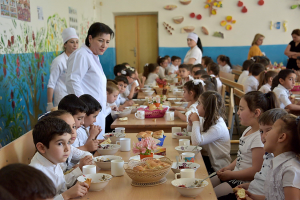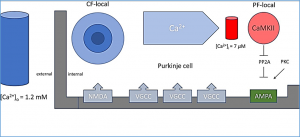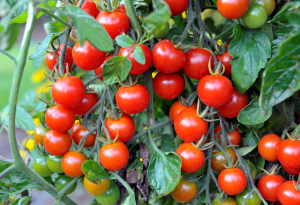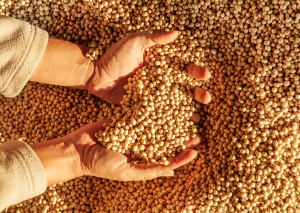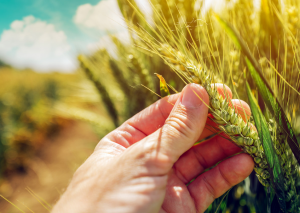She would mix the flour with water, take a chunk of the dough and beat it between her palms to make a big flat disc and then cook it on the wood-fired clay oven. If she offered it to me, I’d turn my nose up. I couldn’t comprehend why she’d choose them over thinner, tastier, easier-to-eat wheat rotis. But a few years back, I switched to the food my grandma ate. I replaced wheat flour in my kitchen with flour made from pearl millets after I saw a report that said that the latter were healthier.
The Food and Agriculture Organization of the United Nations (FAO) and the World Food Programme (WFP) have launched a project to improve the diet of school-aged children, with support from the German Federal Ministry of Food and Agriculture (BMEL). In many countries school meals represent a significant portion of children’s daily diets, and it is vital that these directly contribute to their nutrition needs. The initiative - “School food nutrition guidelines and standards for safeguarding children and adolescents’ right to food”
Schonewille et al. (1) show that genetic deletion of GluN1 N-methyl-D-aspartate receptors (NMDARs) from cerebellar granule cells (GC-GluN1 ko), but not from Purkinje cells (PC-GluN1 ko), impairs long-term depression (LTD) at parallel fiber (PF) to PC synapses and vestibuloocular reflex (VOR) phase reversal. NMDARs are postsynaptically expressed at climbing fiber (CF) synapses (2). Challenging our findings that these postsynaptic receptors promote PF-LTD (3), the authors state “NMDARs in PCs are neither involved in PF-PC synaptic plasticity nor required for cerebellar motor learning” (1). We respectfully reject this conclusion.
Mapping out genomes helps scientists understand how the genes of an organism translate into traits. But there is more to it than just comprehending how a single organism functions and adapts to its environment. It holds key information of how the organism interacts with other organisms, adapts to changes in its environment, and how it thrives for long-term survival. But to unleash the full potential of genomics, we need to view it not as a field of study that focuses on a single species but as a field of study that branches out to include other different scientific fields.
Today CGIAR mourns the passing of Dr. Barbara H. Wells, Global Director of Genetic Innovation, and Director General of the International Potato Center (CIP). Dr. Wells died on February 16, 2022. Dr. Wells’ distinguished career in the agriculture and forestry research and innovation sectors spanned more than 30 years. She joined CGIAR in 2014 as Director General of CIP. Among many achievements there, Dr. Wells presided over an expansion of the Center’s work through partnerships – including with the World Food Programme and McCain Foods – that brought CIP’s innovations to farmers all over the world, achieving scale and delivering impact.
A team of researchers from France's National Research Institute for Agriculture, Food and Environment (INRAE) used CRISPR technology to develop cherry tomatoes with resistance to pepper veinal mottle virus. Their findings are published in Plant Science. Researchers target host susceptibility factors in developing genetic resistances of crops. Using CRISPR-Cas9-NG in cherry tomatoes,
Soybean cyst nematode (SCN) is the most economically destructive pathogen affecting soybean production globally. To combat this pathogen, the researchers produced stable transgenic soybean plants individually containing the inverted repeats of three SCN genes (Hg-rps23, Hg-snb1, and Hg-cpn1) and assessed their resistance to the pathogen. Results showed that host-induced silencing of essential SCN genes could enhance broad-spectrum SCN resistance in stable transgenic soybean plants, without negative impacts on the agronomic performance.
Among all other legumes, soybeans are protein powerhouses, providing a key protein source for humans and livestock around the world. Now, after 30 years, scientists at the University of Illinois have identified a gene with the largest impact on seed protein in soybeans. In 1992, then-graduate student Brian Diers published the first seed protein map for soybeans and identified the region of the genome where the gene might be located.
Gao Caixia's team from the Institute of Genetics and Developmental Biology and Qiu Jinlong's team from the Institute of Microbiology have developed a new wheat mutant, Tamlo-R32, which shows robust resistance to powdery mildew disease and does not display any growth or yield defects. In 2014, the two teams have developed a wheat variant with robust disease resistance, but it grew poorly compared to wild-type wheat.
A food safety and security expert in Japan has recently written about genome editing and genetically modified (GM) crops in an effort to explain risk communication. Takeshi Yamazaki, chairman of the NPO Society for the Science of Food Safety and Security (SFSS) said that GM and genome-edited crops are safer than wild or conventional varieties.The expert said that comparing GM and genome-editing crops with "natural" seems safe at first glance, but it is rather the opposite for food safety experts.


 Curently online :
Curently online :
 Total visitors :
Total visitors :

